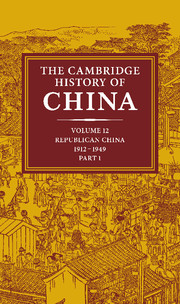Book contents
- Frontmatter
- 1 Introduction: Maritime and continental in China's history
- 2 Economic trends, 1912–49
- 3 The foreign presence in China
- 4 Politics in the aftermath of revolution: the era of Yuan Shih-k'ai, 1912–16
- 5 A constitutional republic: the Peking government, 1916–28
- 6 The warlord era: politics and militarism under the Peking government, 1916–28
- 7 Intellectual change: from the Reform movement to the May Fourth movement, 1895–1920
- 8 Themes in intellectual history: May Fourth and after
- 9 Literary trends I: the quest for modernity, 1895–1927
- 10 The Chinese Communist Movement to 1927
- 11 The Nationalist Revolution: from Canton to Nanking, 1923–28
- 12 The Chinese bourgeoisie, 1911–37
- Bibliographical essay
- Bibliography
- Index
- Republican China – physical features
12 - The Chinese bourgeoisie, 1911–37
Published online by Cambridge University Press: 28 March 2008
- Frontmatter
- 1 Introduction: Maritime and continental in China's history
- 2 Economic trends, 1912–49
- 3 The foreign presence in China
- 4 Politics in the aftermath of revolution: the era of Yuan Shih-k'ai, 1912–16
- 5 A constitutional republic: the Peking government, 1916–28
- 6 The warlord era: politics and militarism under the Peking government, 1916–28
- 7 Intellectual change: from the Reform movement to the May Fourth movement, 1895–1920
- 8 Themes in intellectual history: May Fourth and after
- 9 Literary trends I: the quest for modernity, 1895–1927
- 10 The Chinese Communist Movement to 1927
- 11 The Nationalist Revolution: from Canton to Nanking, 1923–28
- 12 The Chinese bourgeoisie, 1911–37
- Bibliographical essay
- Bibliography
- Index
- Republican China – physical features
Summary
The Revolution of 1911 marked – if not the advent of the bourgeoisie — at least its establishment as a major force in the economic and social life of China. The appearance of a bourgeoisie in the large coastal cities was made possible by the development of the merchant class under the Ming and Ch'ing. During the eighteenth century urbanization was accelerated by a demographic upsurge and an expansion in inter-regional exchanges: the urban population is estimated to have reached 24 million. Merchants intensified and diversified their activities. Local guilds (hui-kuan) multiplied throughout the whole country, and new forms of credit made their appearance in Ningpo and Shanghai well before the Treaty of Nanking opened these ports to foreign trade.
In the second half of the nineteenth century the intervention of the West gave a new impetus to the growth of the coastal cities and brought about tremendous economic change. From this the dominant urban classes quickly sought to profit. Mandarins and merchants each had certain advantages: the former had access to the administration and the public purse, a sense of responsibility, a capacity for initiative; the latter enjoyed personal wealth, group solidarity and a willingness to adopt innovations. From the uneasy collaboration and the partial fusion of these classes there sprang an elite of ill-defined configuration, that of the ‘gentry and merchants’ (shen-shang). At the beginning of the twentieth century, the decline of the central government weakened the position of the mandarins within this elite. But while the Revolution of 1911 reflected and accelerated this development, it was not until the First World War that the new bourgeoisie really sprang into action.
Keywords
- Type
- Chapter
- Information
- The Cambridge History of China , pp. 721 - 825Publisher: Cambridge University PressPrint publication year: 1983
- 3
- Cited by

